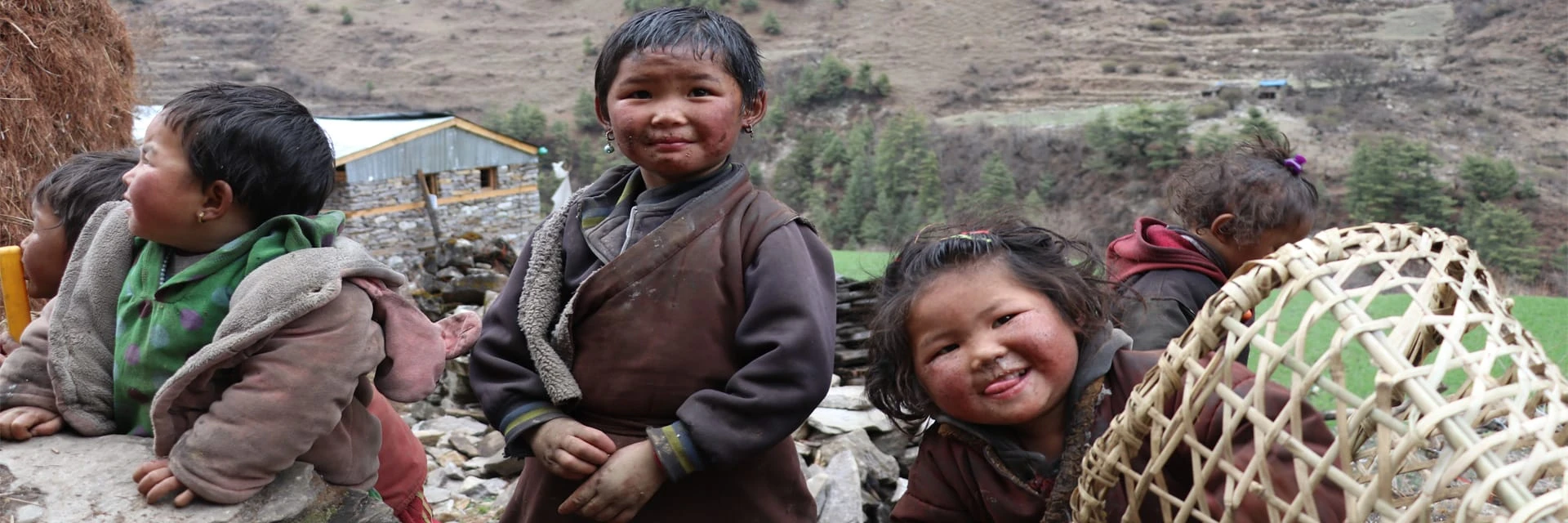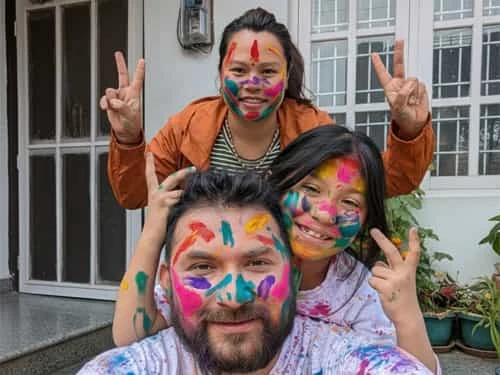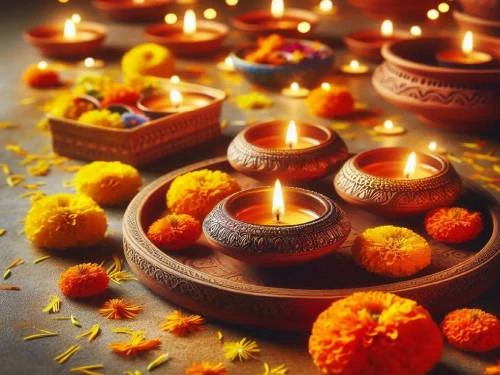Manaslu Trek Route (2025 Updated):
Arughat / Soti Khola → Machha Khola → Jagat → Deng → Namrung → Lho → Sama Gaon → Samdo → Larke Phedi → Larke Pass → Bimthang
Unlike more commercialized treks, Manaslu offers long stretches of peaceful trails with minimal foot traffic. Yes, just you, the mountains, and the occasional villager carrying baskets of grain.
Villages on the Manaslu Trek Route
Manaslu Trekking in Nepal is all about village settlements, local lifestyles, and unique culture. The entire route gives you goosebumps with amazing highlights. Here are the Manaslu Trek Villages, have a look:
Arughat & Soti Khola- Starting Point
Most treks begin from Arughat or Soti Khola. These are not tourist towns, more like small riverside settlements. Hot, humid, noisy with motorbikes sometimes, and chickens running across the street. It feels very “normal Nepal,” farmers working, shops selling biscuits and tea. From here, you cross suspension bridges and start feeling like you have entered another world.
Major Attractions of Arughat & Soti Khola
- Traditional riverside settlements with local farming life
- Warm, humid climate, a stark contrast to higher elevations
- Bustling with locals, motorbikes, and roadside shops
- Gateway to the Manaslu trek experience
- Suspension bridges and early trail excitement
Machha Khola
Machha Khola means “Fish River,” and yes, the Budi Gandaki River runs right next to it. A small place, tea houses lined on the path. People here are mostly Gurung and Magar. They’re friendly, curious, and kids love to wave at trekkers. I remember eating dal bhat here that tasted extra smoky from the kitchen firewood.
Major Attractions of Machha Khola
- Set beside the Budi Gandaki River ("Fish River")
- Cozy teahouses along the trekking path
- Home to the Gurung and Magar ethnic communities
- Friendly locals and curious children
- Authentic dal bhat cooked on firewood
Jagat
Jagat is a special village among the Manaslu Trek villages. This is where your permit gets checked because it’s the start of the Restricted Area. The village looks like it’s carved from stone. Narrow alleyways, stone houses, and prayer flags hanging. Feels like stepping back in time. There’s a UNESCO heritage feel, you know, like people still live the way their grandparents did.
Major Attractions of Jagat
- Official permit check point
- Village built with stone, ancient, preserved look
- Narrow stone-paved lanes and prayer flags
- UNESCO World Heritage ambiance
- Gateway to Tibetan-influenced highlands
Deng
From Jagat, you head higher and reach Deng. It’s a small place, but the vibe changes. You start noticing Tibetan-style mani walls and prayer stones. The people, too, have more Tibetan influence, their faces and their dress. You can feel you are leaving central Nepal and walking closer to Tibet.
Major Attractions of Deng
- First signs of Tibetan culture, mani walls, prayer stones
- High-altitude village with changing landscape
- Remote and serene with minimal distractions
- Cultural transition zone between the Nepalese and Tibetan worlds
Namrung
Namrung is where the trek really opens. You suddenly see the snowy giants, Manaslu and Himal Chuli, looking so close. The village itself has traditional Tibetan houses with carved wooden windows. I stayed in a tea house run by a family, which offered butter tea. Honestly, not my taste, but it warmed me up in the cold evening.
Major Attractions of Namrung
- Panoramic mountain views (Manaslu, Himal Chuli)
- Traditional Tibetan architecture (carved windows, stone houses)
- Local family-run tea houses offering butter tea
- Clear visual change in geography and altitude
Lho Village
If I had to pick a favorite among Manaslu Trek Villages, maybe it's Lho. Early morning here, you wake up, step outside, and get awestruck. Manaslu stands huge right in front of you. There’s Ribung Monastery at the edge of the village, red-robed monks chanting, and kids in maroon uniforms walking to the school run by the monastery. It felt peaceful, spiritual, and unforgettable.
Major Attractions of Lho Village
- Stunning sunrise view of Manaslu from the village
- Ribung Monastery, a cultural and spiritual highlight
- Buddhist monastic life with chanting monks and school children
- Deep sense of peace and spirituality
- Excellent photography and reflection points
Sama Gaun
Samagaun is the biggest village on the circuit, almost feels like a small town. It sits at 3,500m, surrounded by fields where yaks graze. People wear Tibetan dress, spin prayer wheels, and smile at strangers. From here, you can do a side trip to Manaslu Base Camp or Pungyen Gompa. The gompa was magical, tucked into a hill with views that made me quiet for a while. In Sama Gaon, I also ate Tibetan bread with honey, simple but unforgettable.
Major Attractions of Sama Gaon
- Largest village on the Manaslu Circuit (3,500 m)
- Base for side treks: Manaslu Base Camp & Pungyen Gompa
- Fields with yaks, traditional Tibetan clothing, and daily rituals
- Rich cultural interaction with locals
- Tibetan bread & honey, a simple but memorable taste
Samdo
Higher again, close to 3,900 m. Samdo is basically the last proper village before you cross the pass. It’s a Tibetan refugee village, where people moved here decades ago when Tibet closed. You see yak caravans, mani walls, and the way houses are built for the cold wind. Life here is tough, but people smile anyway.
Major Attractions of Samdo
- Located at 3,900 m, the last major village before Larkya La Pass
- Founded by Tibetan refugees, strong cultural roots
- Yak caravans, mani walls, and fortified-style homes
- Harsh weather, strong winds, yet warm hospitality
- A raw, humbling experience of high Himalayan life
Dharamsala (Larke Phedi)
This isn’t really a village, more like a high camp. Just one or two tea houses, very basic, full of trekkers waiting to cross the Larke La Pass. Cold, windy, rocky, nothing much grows. You feel like you’re on another planet. Here are:
Food and Accommodation in Manaslu Villages
Don’t expect luxury. Tea houses are simple, wooden rooms with thin walls. Sometimes shared toilets, sometimes no shower. But the food warms your soul. Dal bhat is king, you can eat as much as you want. Similarly, Tibetan bread in the morning with jam, garlic soup, and noodles. In higher villages, you might get yak meat or butter tea.
It’s not fancy, but after a long walk, that hot plate of dal bhat tastes better than any restaurant.
Tips for Exploring Manaslu Villages
Best Seasons:
Spring (Mar-May) & Autumn (Sept-Nov) – clear skies, cultural festivals, and stable weather.
Cultural Etiquette:
Always walk clockwise around mani walls and chortens.
Communication:
English is limited. Use gestures and smiles, they go a long way.
Hire a Guide:
For safety, cultural insights, and permit handling, highly recommended.
Manaslu Trek Villages FAQs
Which is the most beautiful village in the Manaslu Trekking Nepal?
Hard to pick, but Lho for the monastery and Sama Gaon for size and views.
Can you stay in monasteries in the Manaslu Trek?
Mostly no, but you can visit. Monks are welcoming if you’re respectful.
How many days to reach Sama Gaon?
Normally, 6 to 7 days from Soti Khola, depending on your pace.
Do villagers speak English?
Some young ones, yes, but many are only Nepali or Tibetan. Gestures help a lot.
Are there homestays in the Manaslu Trek?
Yes, in some villages you can stay in local homes, more common in lower areas.
Conclusion
The Manaslu Circuit isn’t just about mountains, it’s about people, stories, and traditions. The villages you walk through aren’t just stops, they’re part of the experience.
From green valleys to dry Tibetan highlands, each village offers its own charm. And each smile, prayer flag, and shared cup of tea tells a story.
If you're seeking a trek that blends breathtaking nature with deep cultural immersion, the Manaslu Trek is hard to beat.




